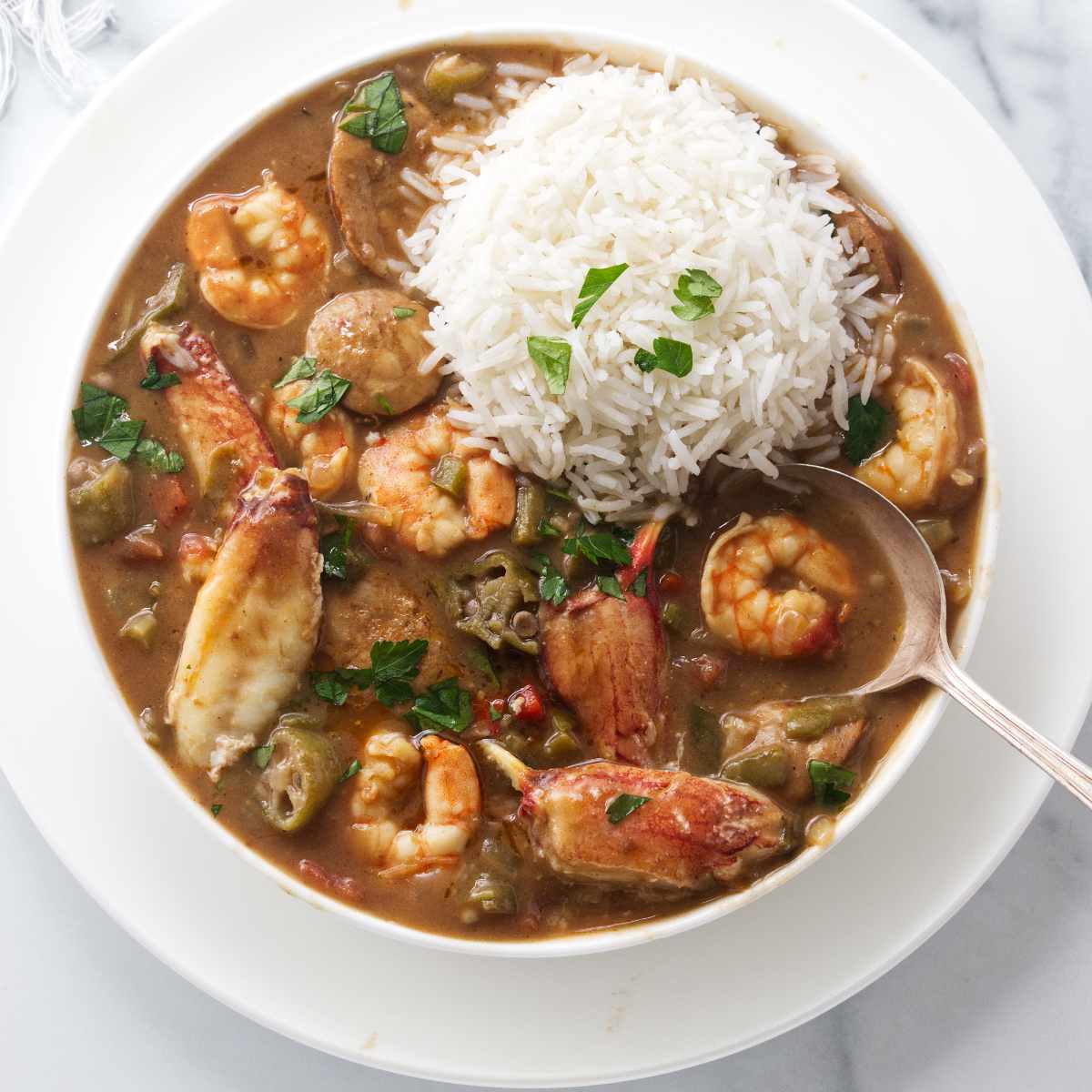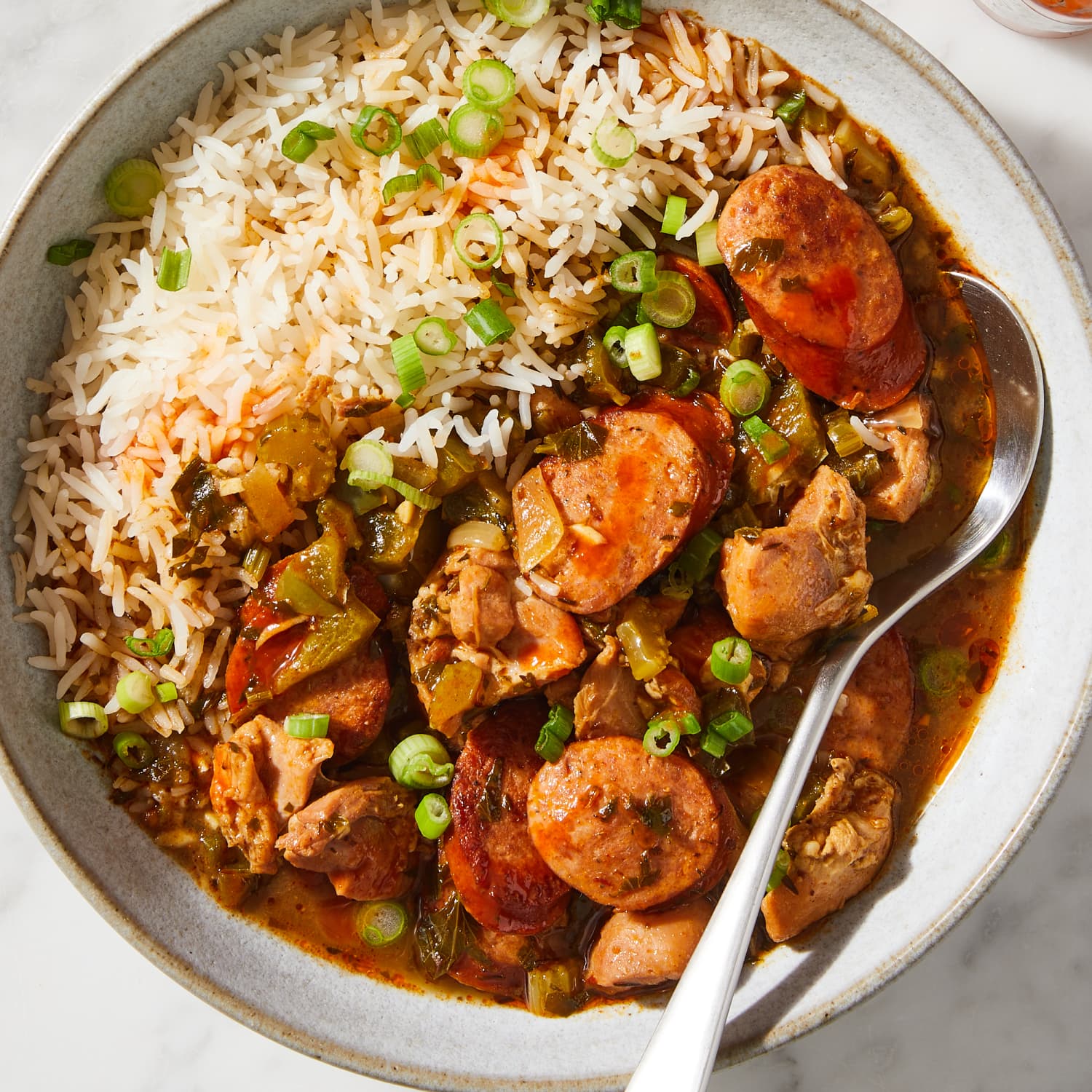Discover the Magic of Gumbo: A Deep Dive into the Classic American Dish
Gumbo is one of the most iconic dishes in the United States, and it’s one that has captured the hearts of food lovers worldwide. Whether you’re a seasoned foodie or someone looking to expand your culinary horizons, this dish is a must-try. In this post, brought to you by The Monroe Hotels, we’ll explore everything you need to know about gumbo, from its history and variations to tips on how to make the perfect bowl. Let’s embark on this flavor-packed journey together!
What Is Gumbo? Unpacking the Dish’s Roots and Origins
Gumbo is a rich, hearty stew that combines a variety of ingredients, including meats, seafood, vegetables, and a flavorful broth, all brought together by a distinct thickening agent. But what sets gumbo apart from other stews or soups is its deep, soulful history that ties it closely to the culture of Louisiana.
:max_bytes(150000):strip_icc()/216888-good-new-orleans-creole-gumbo-DDMFS-4x3-573c0eb9f4584d92a0bd2b4e4065022a.jpg)
The origins of gumbo can be traced back to the 18th century, blending French, African, and Native American influences. It evolved as various cultures in Louisiana added their own twist to the dish, creating a melting pot of flavors that reflect the diversity of the region.
The dish’s name, “gumbo,” comes from the African word for okra, “gombo,” which was one of the primary ingredients used in its early renditions. Okra, alongside other thickening agents like roux or filé powder, plays a crucial role in achieving the perfect gumbo texture—thick and comforting, yet not too heavy.
The Core Ingredients of Gumbo
At the heart of every gumbo lies a handful of essential ingredients that give the dish its unmistakable flavor. Whether you’re making gumbo at home or ordering it at a restaurant, these core elements are what make it stand out.
Roux: The Foundation of Flavor
Roux is a mixture of flour and fat (usually butter or oil) cooked until it turns a golden or brown color. It’s the base of many classic French dishes and serves as the foundation for gumbo’s deep, rich flavor. The process of making roux can take time, but it’s worth the effort for the complex taste it imparts.
The “Holy Trinity”: Onion, Celery, and Bell Peppers
In gumbo, the “holy trinity” refers to the trio of vegetables that provide the aromatic backbone of the dish. Chopped onion, celery, and bell peppers are sautéed in the roux to create a fragrant base. This combination is central to not only gumbo but many other dishes in Creole and Cajun cooking.
Proteins: Seafood, Sausage, or Chicken?
Gumbo is incredibly versatile when it comes to protein choices. Some of the most popular options include:
-
Seafood: Shrimp, crab, and oysters are often featured in gumbo, particularly in coastal areas of Louisiana.
-
Sausage: Andouille sausage, a smoked pork sausage, is a classic addition to gumbo. It adds a smoky, spicy kick to the dish.
-
Chicken: Chicken is another popular protein choice, often paired with sausage for a flavorful and filling stew.

Filé Powder and Okra: The Secret Ingredients
Filé powder, made from ground sassafras leaves, is commonly used in gumbo as a thickening agent and to add a distinctive earthy flavor. Okra, while optional in some recipes, is often added to gumbo for both its thickening properties and its slightly tangy taste.
How to Make the Perfect Gumbo at Home
Making gumbo at home may seem intimidating, but with the right ingredients and a little patience, you can easily create a dish that rivals any restaurant version. Here’s a step-by-step guide to help you master the art of gumbo.
Step 1: Start with a Roux
Begin by making the roux. Heat equal parts oil and flour in a large pot over medium heat. Stir continuously to avoid burning the mixture, and cook it until it reaches a deep brown color. This process can take anywhere from 20 to 40 minutes, so patience is key.
Step 2: Add the Holy Trinity
Once your roux is ready, add the chopped onion, celery, and bell peppers. Sauté them in the roux until they’re softened and fragrant. This will form the base of your gumbo and give it that rich, aromatic flavor.
Step 3: Add Your Proteins
Next, it’s time to add the proteins. If you’re using chicken, sauté it in the roux mixture to get a bit of color before adding the other ingredients. If you’re using sausage or seafood, wait until the soup has simmered for a while before adding these delicate ingredients.
:max_bytes(150000):strip_icc()/Seafood-Gumbo-FT-RECIPE1023-2506d4d1039f4a7a93bc0e76e848a6e4.jpg)
Step 4: Add the Liquid and Seasoning
Pour in chicken stock or broth to create the soup base. Add seasonings such as garlic, bay leaves, thyme, cayenne pepper, paprika, and salt. Stir everything together and bring it to a simmer.
Step 5: Simmer and Thicken
Allow the gumbo to simmer for at least an hour to let the flavors meld together. If you’re using okra, add it during this step. You can also add filé powder to thicken the gumbo further.

Step 6: Serve and Enjoy
Once your gumbo has simmered and thickened to your liking, it’s time to serve! Serve it over a bed of steamed white rice for the perfect balance of flavors.
Variations of Gumbo
While the basic recipe for gumbo remains the same, there are several variations that reflect the diverse food traditions of Louisiana. Here are some of the most popular types of gumbo you might encounter:
Cajun Gumbo vs. Creole Gumbo: What’s the Difference?
The two most common styles of gumbo are Cajun and Creole. While both are delicious, they differ in a few key ways:
-
Cajun Gumbo: Typically, Cajun gumbo is spicier and may not use tomatoes in the base. It often features a darker roux and a heartier mix of meats and seafood.
-
Creole Gumbo: Creole gumbo, on the other hand, is often a bit milder and may incorporate tomatoes into the broth. It tends to be lighter in color and uses a more balanced combination of seafood and chicken.

Seafood Gumbo: A Coastal Delight
For seafood lovers, seafood gumbo is a must-try. It’s typically made with shrimp, crab, and oysters, often served alongside a rich and flavorful broth. The seafood’s natural sweetness pairs perfectly with the savory roux and spices, creating a complex yet balanced dish.
Chicken and Sausage Gumbo: A Classic Combination
Chicken and sausage gumbo is one of the most popular variations. The smoky flavor of the andouille sausage complements the tender chicken, making for a comforting, filling dish that’s perfect for any occasion.

Where to Find the Best Gumbo in Louisiana
If you’re planning a trip to Louisiana, no visit would be complete without tasting some authentic gumbo. The Monroe Hotels is the perfect base for your adventure, offering you a comfortable stay while you explore the culinary delights of the region. From hole-in-the-wall eateries to high-end restaurants, there’s gumbo waiting for you everywhere.
New Orleans
New Orleans is arguably the gumbo capital of the world. You can find a wide range of variations, from classic Creole-style gumbo to modern takes on the dish. Don’t miss out on iconic spots like Commander’s Palace, Dooky Chase’s Restaurant, and Mother’s Restaurant for a taste of authentic gumbo.

Baton Rouge
Baton Rouge, Louisiana’s capital, offers some of the best gumbo outside of New Orleans. Here, you’ll find a blend of Cajun and Creole styles, often with unique local twists. Be sure to check out The Chimes and Paddlewheeler for a satisfying gumbo experience.
The Monroe Hotels: Your Gateway to the Best Gumbo
When it comes to exploring the culinary scene of Louisiana, The Monroe Hotels is your perfect partner. Our properties are located near some of the best food destinations in the region, so you can easily explore everything this incredible state has to offer. After a long day of sightseeing and enjoying gumbo, you’ll return to a luxurious room and unwind in style.
:max_bytes(150000):strip_icc()/__opt__aboutcom__coeus__resources__content_migration__simply_recipes__uploads__2012__04__green-gumbo-horiz-a-1200-419ff82222dc4b8a9d4e7a7a0aa727dd.jpg)
Conclusion: The Flavorful Journey of Gumbo
Gumbo is more than just a dish; it’s a reflection of the rich cultural history of Louisiana. From its humble beginnings to its rise as a culinary icon, gumbo has become a beloved dish enjoyed by food lovers across the globe. Whether you’re making it at home or enjoying it at a restaurant, gumbo is sure to delight your taste buds with its complex flavors and comforting texture.
Details
Namistay chain hotel
- 61-63 Hoang Ke Viem, Bac My Phu, Ngu Hanh Son, Da Nang, Vietnam
- Hotline: 0905 432 992
- Lot 45 An Thuong 29, Bac My Phu, Ngu Hanh Son, Da Nang, Vietnam
- Hotline: 0977 455 546
- 42 An Thuong 26 Street, Bac My Phu, Ngu Hanh Son, Da Nang, Vietnam
- Hotline: 0965 442 842









